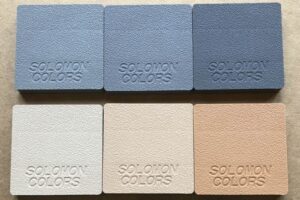 Although your ready-mix supplier can supply you with truckloads of colored concrete, there may be some occasions when you want to color your own. Here’s why and how.
Although your ready-mix supplier can supply you with truckloads of colored concrete, there may be some occasions when you want to color your own. Here’s why and how.
The pros and cons of integral color
There are many reasons to add integral color to a batch rather than broadcasting color hardener. A slab may be too big for workers to access its middle. The customer may want the even color produced by integral pigments instead of the mottled look of color hardener. Integral color won’t chip off. And integral color is the only choice for vertical surfaces enclosed in forms.
The biggest drawback of integral color is the difficulty of matching colors from the color chip to the job, from load to load, and even from one end of the truck to the other. Color chips can give the customer only a general idea of what to expect. For one thing, the chip was made to represent a batch made at the manufacturer’s headquarters. In your area, cement and sand may be lighter or darker than what the manufacturer used, and additives such as fly ash will bring their own colors to the mix. For another thing, the color chip represents an unsealed surface. Sealing the surface will make the color darker and richer. If the color is critical, as when existing concrete must be matched, a sample slab is essential.
 Outwitting Murphy
Outwitting Murphy
Once you’ve developed a formula that makes a good-looking sample, much can go wrong when that sample is scaled up to production size. The color is extremely sensitive to how much water is in the mix and to the color of the cement and aggregate in the mix.
To minimize these problems, Lyle Langeliers of Alco Concrete in Eugene, Ore., always takes the task of coloring into his own hands, whether the job is large or small. “If three different truck drivers weigh out three different loads, you’re going to get three different looks,” he said. Accordingly, Langeliers weighs out the colorant and delivers the exact amount to the ready-mix plant. This practice doesn’t entirely eliminate the opportunity for error, but it makes it easier to pinpoint who made an error, should it be necessary to redo the job.
 Although many powdered colorants come in bags that are supposed to degrade in the mix truck, Langeliers requires the ready-mix drivers to open the bags and dump their contents into the truck. He explained, “The four corners of those bags have multiple folds, and about 25 percent of the time you’ll get a big fist-sized ball of color wrapped up in that fold that doesn’t disintegrate. It’s always out in the middle of the slab. Someone has to climb out there and get it, and now the color has changed a little bit. The concrete drivers don’t want to handle the color, but we ask them to open the bags and dump the color in. That always costs me some doughnuts for the truck drivers.”
Although many powdered colorants come in bags that are supposed to degrade in the mix truck, Langeliers requires the ready-mix drivers to open the bags and dump their contents into the truck. He explained, “The four corners of those bags have multiple folds, and about 25 percent of the time you’ll get a big fist-sized ball of color wrapped up in that fold that doesn’t disintegrate. It’s always out in the middle of the slab. Someone has to climb out there and get it, and now the color has changed a little bit. The concrete drivers don’t want to handle the color, but we ask them to open the bags and dump the color in. That always costs me some doughnuts for the truck drivers.”
Doughnuts are powerful, but to make the job less messy and more fool-proof, Langeliers repackages the colorant in heavy-duty transparent plastic bags. So far only one driver has managed to drop a plastic bag into the load, he reported.
Even if you weigh out the color yourself, plenty can still go wrong at the ready-mix plant. Transit time variation, wash water left in the truck, the order in which ingredients are added to the mixer, and variation between different lots of cement or aggregate can all cause two truckloads prepared with the same amount of colorant to have different colors.
Don’t just dump
For this reason, you might want to add your own color at the job site instead of at the plant. You’ll also be adding your own color if you have a small job using a portable mixer. However, no matter what the size of the load, there’s more to adding colorant than throwing it in and running the mix truck for a while. “The manufacturers tell you in the specs that you can do it like that, but that’s not the safe way to do it,” Langeliers said. “It’s virtually impossible to get an even color from front to back. The back of the load seems to absorb more of the material. Then as you are pouring it, you start to get the gray streaks of the natural concrete.”
Instead, Langeliers suggested adding part of the colorant, running the mixer, then reversing it and starting to discharge the truck. “After you start to discharge, the load is lying in there flat. Now when you put more color in it, it will flow forward [instead of staying in the back of the truck]. If you do that multiple times, you will get a consistent mix.” Both powdered and liquid colorants will mix better this way, and many manufacturers do recommend this procedure. Jerry Garceau of Butterfield Colors noted that reversing the drum for discharge before adding colorant will ensure that the pigments get into the concrete instead of accumulating on the fins.
 Of course, if you’re using a portable mixer, add the colorant early in the mixing process per the colorant manufacturer’s directions, which generally involve adding part of the water and cement to the mixer, mixing, then adding the rest of the materials.
Of course, if you’re using a portable mixer, add the colorant early in the mixing process per the colorant manufacturer’s directions, which generally involve adding part of the water and cement to the mixer, mixing, then adding the rest of the materials.
Another factor to consider when adding color at the job site is any additional water that the process brings to the mix. “When you add color at the site, you have to wash the fins down,” Langeliers explained. “Every gallon of water that you add weakens the concrete. So, for example, if you order a load of 3,000-psi concrete at a 4.5-inch slump, when you put color in and wash the fins down, you will add 10 gallons of water to the mix, and it will no longer be 3,000 psi. If you know you’re going to add color this way, order the concrete at a 3.5-inch slump.” Adding water also lightens the color by diluting the pigment — another reason to make it a rule to adjust slump with water reducers rather than with water.
The finishing touches
Finally, how you handle colored concrete after the pour has a big effect on the appearance. For the color to be uniform, the whole surface must have a uniform water:cement ratio as it cures. Late troweling, hard troweling, too-rapid drying of the surface, or covering the surface with plastic all can produce blotches by creating areas of higher and lower water:cement ratio. On vertical surfaces, leaky forms or those that pull away from the concrete can create areas that dry prematurely, creating dark blotches.
If you patch defects in the surface, remember that stiff patching mortar contains less water than concrete that is to be poured, and will come out darker if color is added in the same proportion as it was to the poured concrete. Replacing some of the gray cement in the mortar with white portland cement will adjust the color. Davis Colors recommends starting with a mixture of 3 parts sand, 1 part gray cement, and 1 part white cement, with aggregate added to match the rest of the slab. Patch as soon as possible after the pour so that the patches cure under the same conditions as the rest of the job.
The metal oxide pigments used in integral colors don’t fade with exposure to sunlight, but to keep the color fresh it’s a good idea to keep the surface protected with sealant, which will minimize dusting of the concrete itself.
















